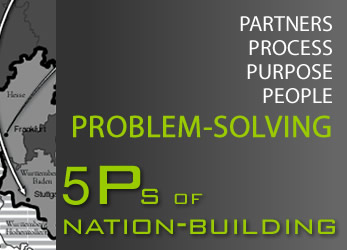Chapter 4 excerpt
Germany: Reconstruction after Fascism
Posters from a European Recovery Program (ERP) international poster contest to promote the Marshall Plan on the theme, "Intra-European Co-operation for a Better Standard of Living."
As part of its public relations campaign for the Marshall Plan, the European Recovery Program (ERP) sponsored an international poster contest on the theme, "Intra-European Co-operation for a Better Standard of Living." Over 10,000 entries from 13 countries were submitted in local country competitions from which the 25 award-winning posters were selected. Prominent graphic arts experts, each representing a different Marshall Plan country, made up the jury. These posters are a sample of the winners. Published by the Economic Cooperation Administration.
Date: 1950. ©Marshall Plan Poster Competition ref C97-33
 In 1947, two years after the great Allied victory against fascism in
Europe, it appeared that the United States would, once again, lose
the peace. The New York Times reported that the average daily food
ration in Germany was 1,200 calories—less than half the daily consumption
in neighboring Scandinavia, perhaps a third of the daily consumption
in the United States. Even the Poles were eating more than
the Germans! One traveler observed that the "average German adult
has lost from two to ten pounds in the last three months; he now is
thirty pounds underweight, and his wife is almost twenty-five pounds
below normal weight for her age. Children have not lost weight in recent
months because of a school feeding program, but they are nine per
cent below the pre-war normal weight scale."
In 1947, two years after the great Allied victory against fascism in
Europe, it appeared that the United States would, once again, lose
the peace. The New York Times reported that the average daily food
ration in Germany was 1,200 calories—less than half the daily consumption
in neighboring Scandinavia, perhaps a third of the daily consumption
in the United States. Even the Poles were eating more than
the Germans! One traveler observed that the "average German adult
has lost from two to ten pounds in the last three months; he now is
thirty pounds underweight, and his wife is almost twenty-five pounds
below normal weight for her age. Children have not lost weight in recent
months because of a school feeding program, but they are nine per
cent below the pre-war normal weight scale."
Food shortages were undermining political order in the American
and British occupied zones of Germany. They were the "basis
of nearly every problem before United States Military Government,"
according to one observer. General Lucius Clay, the commander of
American forces in Germany, agreed. Hunger motivated labor unrest,
public disillusion, and communist agitation.
Clay referred to Germany
as a "bankrupt" society, desperately in need of new direction
from without as well as within. Work stoppages and demonstrations
in the coal-rich Ruhr Valley only reinforced this anxiety about Germany's
political future. Asked by an American journalist about labor
resistance, one coal miner explained: "we don't really care. Right now
we get more to eat if we mine more but coal itself doesn't do
us any good. Part of it is exported to Lord knows where, and what
should go to our industry doesn't—we're not allowed to produce all
the things we need. Where is the stuff to rebuild our homes? Where
are the clothes I need for myself and my wife and children?"
Meeting with local German trade union and political figures in the
burnt-out cities of Frankfurt, Stuttgart, and Munich, the American political
advisor for Germany, Robert Murphy, observed: "Except for the
immediate post-combat period in 1945 when Germans were stunned
by events, I have not found German morale any lower than it is today."
Murphy warned that after the winter of 1946–1947, "the German people
physically and psychologically will be unable to stand another winter
of hunger and cold under miserable housing conditions in destroyed
cities and in economic and political hopelessness."
Murphy closed his
analysis with an ominous prediction: "It is apparent that German sentiment
is increasingly troubled. The shock of the combat period has
subsided. Under pressure of economic misery German determination
to survive will undoubtedly be manifest in future political action."

Click to learn more about the 5 "P"s of nation-building.
This chapter focuses on the challenges of rebuilding Germany and other countries after the devastation of the Second World War. American efforts emphasized nation-building in Germany as a basis for PROBLEM-SOLVING.




